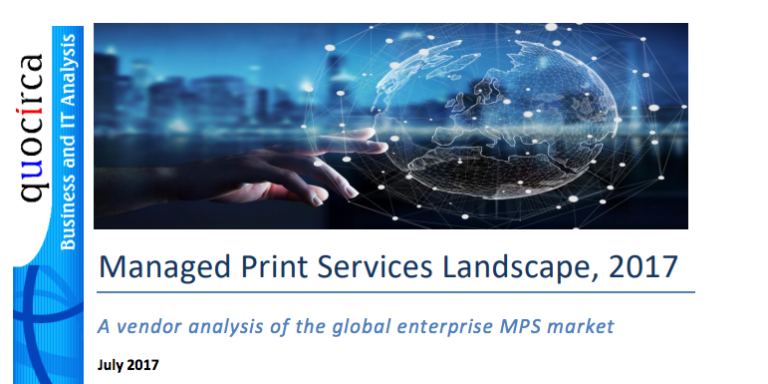(Because the topic of the digital workplace is hotter than ever, we’re republishing this blog post for those who may have started their digital journey since its original publication. Today you could just as easily swap out “Digital Transformation” for “MCS,” and the story stays almost the same. The difference is that now, the tale is less visionary and more actuality, given recent technology announcements, and the post has been updated with links to new information.)
Your MCS Strategy Starts with Your MPS Strategy
Large enterprises get Managed Print Services or MPS. They. Get. It. They’ve been through the pitches and listened to the benefits. They’ve sent out the RFPs, studied the proposals and signed the contracts. But are they ready for Managed Content Services or MCS?
According to Gartner, “MCS is a comprehensive package that rationalizes, streamlines and optimizes business communications by providing customers with consultative help, software and implementation … In the early stages of maturation, it is tightly coupled with MPS and focuses on communications inside of the organization.”
Want to get your MCS strategy off the ground? Leverage your MPS foundation and your MPS provider’s experience, assuming they have the ability to take you to the next level. Not all do. Pay attention to their experience in smartly bundling devices, software, services and support to lay the groundwork for MCS. A forward-looking provider already thinks that way. The Next Generation MPS approach of access and optimize, secure and integrate, automate and simplify is designed to pave the way to MCS in stages.
Make MPS Your Bridge From Print to Content
The bridge between MPS and MCS becomes clearer when you consider MCS as an evolution of MPS. The focus shifts from devices and printing to capture and content, and then to workflow and sharing. It’s about the birth, use, transformation and death of content, both printed and electronic. In other words — the content life cycle. It’s hard to separate MPS from that view, since it plays a role in so many business workflows, from employee onboarding to loan application processing.
MCS requires strategies for secure print, and for sharing and accessing documents inside and outside the enterprise, requirements that are already part of the MPS value prop. However, even “paper-optimized” operations must still deal with printed documents from outsiders like customers and suppliers. MCS involves scanning documents and making them digital to compress the content life cycle, launch workflow automation and make the information move faster. Good print security practice requires that users be authenticated as they scan information at a device, and MPS provides that bridge between device-level security and the beginning of MCS workflow. Now there’s also a mobile printing component, which ties into MPS capabilities.
Easing into Business Transformation
MCS is part of the ongoing evolution of the enterprise document environment, fighting for IT attention along with other factors like mobility and cloud. The role of Next Gen MPS is to transition from helping enterprises optimize business printers and multifunction printers (MFPs), to handling their documents more efficiently and eliminating printing where practical.
This isn’t an overnight transformation of your current state. A three-stage MPS approach solves problems gradually in prescribed steps, and this approach leads neatly into MCS. You don’t have to overhaul big chunks of infrastructure and deal with the disruption that goes along with it. The MPS-to-MCS path gives you breathing room as you undergo transition, with your MPS provider guiding your strategy and doing the work to implement it.
MPS Fleet Optimization Prepares You for MCS
MPS and MCS both embrace the premise that enterprises have an abundance of paper that must be brought under control. As teams wean off paper, or more likely, come to terms with hybrid paper and digital document environments, a forward-looking MPS strategy leverages the environment you have to get to the digital workplace you want. MPS slims down your fleet to prepare you for the next generation of document needs. Your provider should help you make that journey.
It’s not just about putting document security safeguards in place. When moving to an MCS environment makes sense for your enterprise, you’ll need an MPS vendor to continuously optimize your fleet size down, so you’re not stuck with several years of leases just as you’re ready to start digitizing content. Your vender should be very strategic about what equipment to keep in place and ensure flexibility in your contract. Sit down soon with your MPS provider and find out how they prepared they are to get you on the road to the digital workplace.
Don’t have an MPS provider? Use these 16 questions to find the right partner for your business.




I represent Burhani Managed IT Services, an IT Services Company in Dubai and Xerox Reseller.
This market is still not even mature for MPS – how does one accelerate the pace of adoption of next-generation business technology when the consumer is not willing to change?
Good point, sir. Often it helps to share stories of other successes, or to present a step-by-step roadmap for your clients. When they see one success, even a small one, they may be more interested in going farther.